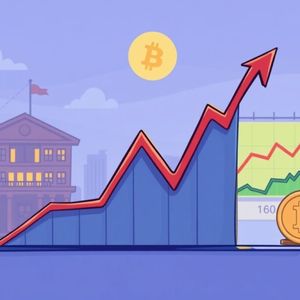BitcoinWorld Asia FX: Unlocking Opportunities Amidst Dollar Weakness and Looming Rate Cuts In the interconnected world of global finance, even the slightest tremors in one market can send ripples across others. For cryptocurrency investors, understanding the broader macroeconomic landscape is not just beneficial; it is essential. Currently, the spotlight is firmly on the muted performance of Asia FX , the persistent US Dollar weakness , and the critical role of incoming labor market data in shaping expectations for future interest rate cuts . These factors are not merely abstract economic indicators; they are powerful forces that can significantly influence the flow of capital into risk assets, including digital currencies. As central banks navigate a complex economic environment, their decisions on monetary policy, particularly regarding rate adjustments, become pivotal. This article will delve into these intricate dynamics, offering insights into how these global shifts are poised to impact markets and what investors should consider as they chart their strategies. Understanding Asia FX Dynamics Amidst Global Shifts The term ‘muted’ for Asia FX suggests a period of relative stability or limited movement for currencies across the Asian continent. This phenomenon is often a result of a confluence of factors, ranging from internal economic policies to external pressures from major global economies. Asian currencies are a diverse group, each influenced by its unique economic structure, trade balances, and central bank interventions. However, a common thread currently observed is their reaction to broader global trends, especially those originating from the United States and Europe. Several key elements contribute to the current state of Asian currencies: Trade Balances: Export-oriented economies in Asia are highly sensitive to global demand. A slowdown in major export markets can lead to weaker trade surpluses, impacting currency strength. Conversely, robust global trade can bolster Asian currencies. Capital Flows: Investor sentiment towards emerging markets, driven by interest rate differentials and risk appetite, dictates the flow of foreign capital. When global investors seek higher yields, capital often flows into Asia, strengthening local currencies. The opposite occurs during periods of risk aversion. Domestic Monetary Policy: Each Asian central bank sets its own interest rates and conducts monetary operations, which directly influence the attractiveness of its currency. Divergent policies across the region can lead to varied currency performances. Geopolitical Developments: Regional tensions or global conflicts can introduce uncertainty, leading to capital flight and currency depreciation in affected areas. For instance, the Japanese Yen (JPY) has recently faced pressure due to the Bank of Japan’s ultra-loose monetary policy, contrasting sharply with tightening policies elsewhere. The Chinese Yuan (CNY) remains influenced by the nation’s economic growth trajectory and government policy decisions. Meanwhile, currencies like the Indian Rupee (INR) and the Singapore Dollar (SGD) often reflect a blend of domestic economic resilience and sensitivity to global capital flows. Understanding these underlying forces is crucial for anticipating the trajectory of Asia FX and its broader implications for global financial markets. The Persistent US Dollar Weakness: A Tailwind for Risk Assets? The US Dollar weakness has been a significant narrative in financial markets, driven primarily by evolving expectations around the Federal Reserve’s monetary policy. After an aggressive hiking cycle to combat inflation, the market is now pricing in the likelihood of future interest rate cuts . This shift in sentiment often leads to a depreciation of the dollar for several reasons: Interest Rate Differentials: Lower interest rates in the US make dollar-denominated assets less attractive compared to those in countries with higher or stable rates, encouraging capital outflow from the US. Inflation Expectations: If inflation is perceived to be under control, the need for a strong dollar to maintain purchasing power diminishes. Risk-On Sentiment: A weaker dollar often coincides with a global ‘risk-on’ environment. When the dollar is strong, it typically signals global economic uncertainty, driving investors to seek safety in the world’s reserve currency. Conversely, a weakening dollar suggests improved global economic conditions or a greater appetite for risk, leading investors to diversify into other currencies and risk assets like equities and cryptocurrencies. The implications of a weaker dollar are far-reaching. For commodity markets, a depreciating dollar often makes dollar-denominated commodities (like oil and gold) cheaper for international buyers, potentially boosting demand and prices. For multinational corporations, it can make US exports more competitive and improve the value of overseas earnings when converted back to dollars. Crucially, for the cryptocurrency market, US Dollar weakness has historically been a bullish signal. As the dollar loses its relative appeal, investors often look for alternative stores of value or high-growth assets. Bitcoin, often dubbed ‘digital gold,’ and other cryptocurrencies can benefit from this reallocation of capital, as investors seek to hedge against traditional currency devaluation or chase higher returns in a more accommodative monetary environment. Decoding Labor Market Data: The Fed’s Crucial Puzzle Piece Central banks, especially the Federal Reserve, pay meticulous attention to labor market data . It serves as a vital barometer of economic health, influencing monetary policy decisions and, consequently, global financial markets. Key reports like the Non-Farm Payrolls (NFP), unemployment rate, average hourly earnings, and Job Openings and Labor Turnover Survey (JOLTS) provide a comprehensive picture of employment trends. Why is this data so critical? Inflationary Pressures: A tight labor market, characterized by low unemployment and strong wage growth, can fuel inflationary pressures. When employers compete for scarce workers, they often raise wages, which can then be passed on to consumers in the form of higher prices. Economic Growth Indicator: Robust job creation signals a healthy and expanding economy, indicating strong consumer demand and business activity. Conversely, weakening employment figures can signal an impending economic slowdown or recession. Monetary Policy Direction: The Fed’s dual mandate includes achieving maximum employment and stable prices. Therefore, the state of the labor market directly informs their decisions on whether to raise, hold, or cut interest rates. A persistently strong labor market might delay rate cuts, while signs of significant weakening could accelerate them. For investors, interpreting labor market data is key to anticipating central bank moves. A hotter-than-expected jobs report might lead markets to push back expectations for interest rate cuts , potentially strengthening the dollar and dampening enthusiasm for risk assets. Conversely, a softer report could bring forward rate cut expectations, weakening the dollar and potentially boosting assets like cryptocurrencies. The upcoming releases of this data will be scrutinized for any signs of cooling in the employment sector, as this would provide the Fed with more room to consider easing monetary policy without reigniting inflation concerns. This continuous dance between economic data and policy expectations keeps markets on edge and requires constant vigilance from investors. The Anticipation of Interest Rate Cuts: What’s Next? The market’s fervent anticipation of interest rate cuts by major central banks, particularly the Federal Reserve, is perhaps the most dominant theme currently influencing global markets. After a period of aggressive monetary tightening, the focus has shifted towards when and how quickly central banks will begin to ease policy. This pivot is driven by several factors, including cooling inflation, signs of economic deceleration, and the desire to avoid a deep recession. What are the potential impacts of these anticipated cuts? Bond Yields: Expectations of lower future rates typically lead to a decrease in bond yields, making fixed-income investments less attractive. Equity Markets: Lower interest rates reduce borrowing costs for companies, potentially boosting corporate profits and making equities more appealing to investors. This can lead to a ‘risk-on’ rally. Currency Markets: As discussed, lower rates can weaken a currency (e.g., the US Dollar), as its assets become less attractive relative to those in other countries. Real Estate: Lower mortgage rates can stimulate the housing market, making homeownership more affordable. For the cryptocurrency space, a cycle of rate cuts is generally viewed as a positive catalyst. Lower interest rates reduce the opportunity cost of holding non-yielding assets like cryptocurrencies. Furthermore, an environment of easier money tends to encourage greater risk-taking, as investors seek higher returns in a world where traditional safe assets yield less. This could translate into increased capital allocation towards digital assets, potentially driving up prices. However, the timing and magnitude of these cuts remain subject to incoming economic data. Any unexpected resurgence in inflation or surprising strength in the labor market data could delay the Fed’s pivot, introducing volatility and uncertainty back into the markets. Investors are keenly watching every speech, every economic report, and every policy statement for clues on the exact trajectory of these crucial rate adjustments. Navigating the Global Economic Outlook: Challenges and Opportunities The current global economic outlook is a tapestry woven with threads of both challenge and opportunity. While the prospect of interest rate cuts and a potentially weaker US Dollar offers a glimmer of hope for risk assets, several underlying challenges demand careful consideration from investors. Challenges to Monitor: Persistent Inflation: Although inflation has cooled, the risk of a resurgence, perhaps due to supply chain disruptions or geopolitical events, remains. This could force central banks to maintain higher rates for longer, dampening market enthusiasm. Geopolitical Tensions: Ongoing conflicts and rising geopolitical risks can create significant market volatility, disrupt trade, and impact energy prices, casting a shadow over the global recovery. Sovereign Debt Levels: Many nations accumulated significant debt during the pandemic. Rising interest rates (even if temporary) and slower growth could make servicing this debt more challenging, posing risks to financial stability. Regional Economic Divergence: While some economies might show resilience, others could struggle with slower growth or recession, leading to uneven global performance. This can particularly affect Asia FX , where individual economies have different exposures and buffers. Opportunities to Seize: Diversification: In an uncertain environment, diversifying portfolios across different asset classes, including traditional assets and digital currencies, can help mitigate risks and capture varied growth opportunities. Emerging Markets Growth: A weaker dollar and potential rate cuts could provide tailwinds for emerging markets, making their assets more attractive and potentially leading to stronger currency performance. This could specifically benefit certain segments of Asia FX . Technological Innovation: Sectors driven by technological advancements, including blockchain and AI, continue to offer high growth potential, irrespective of broader economic headwinds. Strategic Entry Points: Market volatility, while challenging, can also present strategic entry points for long-term investors in undervalued assets, including promising cryptocurrencies. For investors, the actionable insight is to remain agile and informed. Understanding the nuances of the global economic outlook , from central bank policy to geopolitical shifts, allows for more robust decision-making. The interconnectedness of Asia FX , the US Dollar weakness , the implications of labor market data , and the anticipation of interest rate cuts all point to a dynamic period ahead, ripe with both potential pitfalls and significant opportunities. Conclusion: Navigating the Interconnected Global Market The current financial landscape is characterized by a delicate balance of forces: the subdued movements in Asia FX , the persistent easing of the US Dollar weakness , the pivotal role of labor market data , and the overarching expectation of future interest rate cuts . These elements are not isolated; they form a complex web that dictates capital flows, investor sentiment, and ultimately, the performance of various asset classes, including the burgeoning cryptocurrency market. For investors, particularly those engaged with digital assets, the message is clear: macroeconomics matters. A weakening dollar, often a precursor to a ‘risk-on’ environment, can provide a significant tailwind for cryptocurrencies. However, this bullish sentiment is intricately linked to the precise timing and pace of central bank policy adjustments, which in turn are heavily influenced by incoming economic data, especially from the labor market. The global economic outlook , while showing signs of potential easing, still harbors uncertainties that demand a cautious yet opportunistic approach. Staying informed about these global economic shifts is not just about reacting to headlines; it’s about understanding the underlying mechanisms that drive market movements. By keeping a close watch on central bank communications, key economic indicators, and geopolitical developments, investors can better position their portfolios to navigate the opportunities and challenges that lie ahead in this dynamic financial era. To learn more about the latest Forex market trends and global economic outlook , explore our articles on key developments shaping currency markets and investment strategies. This post Asia FX: Unlocking Opportunities Amidst Dollar Weakness and Looming Rate Cuts first appeared on BitcoinWorld and is written by Editorial Team
















